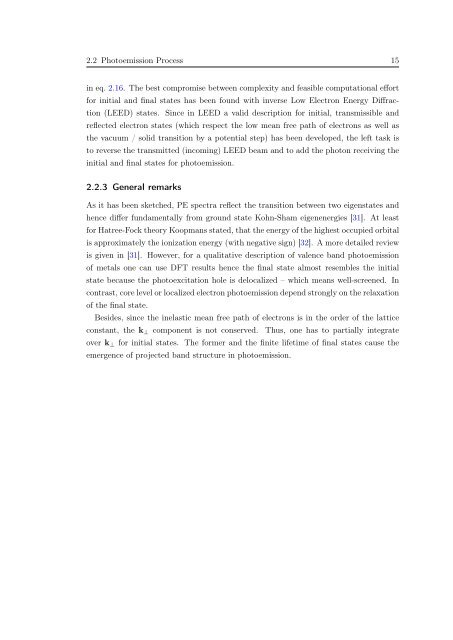Diploma - Max Planck Institute for Solid State Research
Diploma - Max Planck Institute for Solid State Research
Diploma - Max Planck Institute for Solid State Research
Create successful ePaper yourself
Turn your PDF publications into a flip-book with our unique Google optimized e-Paper software.
2.2 Photoemission Process 15<br />
in eq. 2.16. The best compromise between complexity and feasible computational ef<strong>for</strong>t<br />
<strong>for</strong> initial and final states has been found with inverse Low Electron Energy Diffraction<br />
(LEED) states. Since in LEED a valid description <strong>for</strong> initial, transmissible and<br />
reflected electron states (which respect the low mean free path of electrons as well as<br />
the vacuum / solid transition by a potential step) has been developed, the left task is<br />
to reverse the transmitted (incoming) LEED beam and to add the photon receiving the<br />
initial and final states <strong>for</strong> photoemission.<br />
2.2.3 General remarks<br />
As it has been sketched, PE spectra reflect the transition between two eigenstates and<br />
hence differ fundamentally from ground state Kohn-Sham eigenenergies [31]. At least<br />
<strong>for</strong> Hatree-Fock theory Koopmans stated, that the energy of the highest occupied orbital<br />
is approximately the ionization energy (with negative sign) [32]. A more detailed review<br />
is given in [31]. However, <strong>for</strong> a qualitative description of valence band photoemission<br />
of metals one can use DFT results hence the final state almost resembles the initial<br />
state because the photoexcitation hole is delocalized – which means well-screened. In<br />
contrast, core level or localized electron photoemission depend strongly on the relaxation<br />
of the final state.<br />
Besides, since the inelastic mean free path of electrons is in the order of the lattice<br />
constant, the k ⊥ component is not conserved. Thus, one has to partially integrate<br />
over k ⊥ <strong>for</strong> initial states. The <strong>for</strong>mer and the finite lifetime of final states cause the<br />
emergence of projected band structure in photoemission.
















